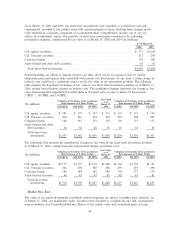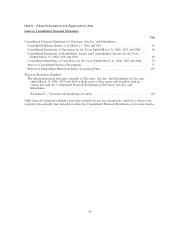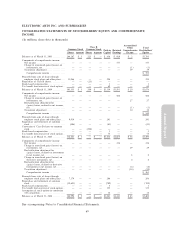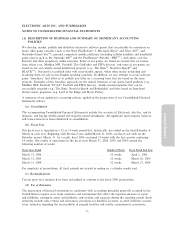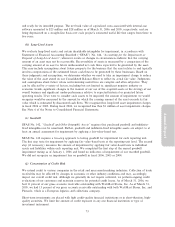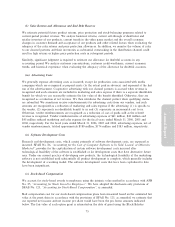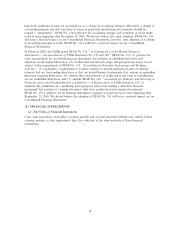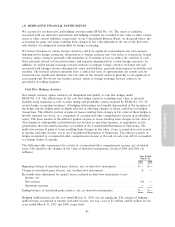Electronic Arts 2006 Annual Report Download - page 145
Download and view the complete annual report
Please find page 145 of the 2006 Electronic Arts annual report below. You can navigate through the pages in the report by either clicking on the pages listed below, or by using the keyword search tool below to find specific information within the annual report.
and ready for its intended purpose. The net book value of capitalized costs associated with internal-use
software amounted to $23 million and $28 million as of March 31, 2006 and 2005, respectively, and are
being depreciated on a straight-line basis over each project's estimated useful life that ranges from three to
Ñve years.
(h) Long-Lived Assets
We evaluate long-lived assets and certain identiÑable intangibles for impairment, in accordance with
Statement of Financial Accounting Standard (""SFAS'') No. 144, ""Accounting for the Impairment or
Disposal of Long-Lived Assets'', whenever events or changes in circumstances indicate that the carrying
amount of an asset may not be recoverable. Recoverability of assets is measured by a comparison of the
carrying amount of an asset to future undiscounted net cash Öows expected to be generated by the asset.
This may include assumptions about future prospects for the business that the asset relates to and typically
involves computations of the estimated future cash Öows to be generated by these businesses. Based on
these judgments and assumptions, we determine whether we need to take an impairment charge to reduce
the value of the asset stated on our Consolidated Balance Sheet to reÖect its actual fair value. Judgments
and assumptions about future values and remaining useful lives are complex and often subjective. They
can be aÅected by a variety of factors, including but not limited to, signiÑcant negative industry or
economic trends, signiÑcant changes in the manner of our use of the acquired assets or the strategy of our
overall business and signiÑcant under-performance relative to expected historical or projected future
operating results. If we were to consider such assets to be impaired, the amount of impairment we would
recognize would be measured by the amount by which the carrying amount of the asset exceeds its fair
value which is estimated by discounted cash Öows. We recognized no long-lived asset impairment charges
in Ñscal 2006 or 2005. During Ñscal 2004, we recognized less than $1 million of asset impairment charges.
See Note 6 of the Notes to Consolidated Financial Statements.
(i) Goodwill
SFAS No. 142, ""Goodwill and Other Intangible Assets'' requires that purchased goodwill and indeÑnite-
lived intangibles not be amortized. Rather, goodwill and indeÑnite-lived intangible assets are subject to at
least an annual assessment for impairment by applying a fair-value-based test.
SFAS No. 142 requires a two-step approach to testing goodwill for impairment for each reporting unit.
The Ñrst step tests for impairment by applying fair value-based tests at the reporting unit level. The second
step (if necessary) measures the amount of impairment by applying fair value-based tests to individual
Annual Report
assets and liabilities within each reporting unit. We completed the Ñrst step of the annual goodwill
impairment testing as of January 1, 2006 and found no indicators of impairment of our recorded goodwill.
We did not recognize an impairment loss on goodwill in Ñscal 2006, 2005 or 2004.
(j) Concentration of Credit Risk
We extend credit to various companies in the retail and mass merchandising industries. Collection of trade
receivables may be aÅected by changes in economic or other industry conditions and may, accordingly,
impact our overall credit risk. Although we generally do not require collateral, we perform ongoing credit
evaluations of our customers and maintain reserves for potential credit losses. As of March 31, 2006, we
had 11 percent of our gross accounts receivable outstanding with Wal-Mart Stores, Inc. As of March 31,
2005, we had 13 percent of our gross accounts receivable outstanding with both Wal-Mart Stores, Inc. and
Pinnacle, which is a European logistics and collections company.
Short-term investments are placed with high credit-quality Ñnancial institutions or in short-duration, high-
quality securities. We limit the amount of credit exposure in any one Ñnancial institution or type of
investment instrument.
73



